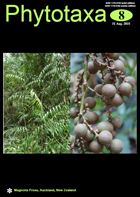Issue:
Vol. 8 No. 1: 31 Aug. 2010
Type: Article
Published: 2014-08-31
Page range: 46-50
Abstract views: 18
PDF downloaded: 1
The transfer of Vernonia perangusta to the genus Vernonanthura (Vernonieae, Asteraceae) and the correct name for Vernonanthura phosphorica
Instituto de Botánica del Nordeste (UNNE-CONICET), Casilla de Correo 209, 3400 Corrientes, Argentina
Instituto de Botánica del Nordeste (UNNE-CONICET), Casilla de Correo 209, 3400 Corrientes, Argentina.
Facultad de Ciencias Exactas y Naturales y Agrimensura, Universidad Nacional del Nordeste, Corrientes, Argentina
Brazil
Compositae
Lepidaploa complex

